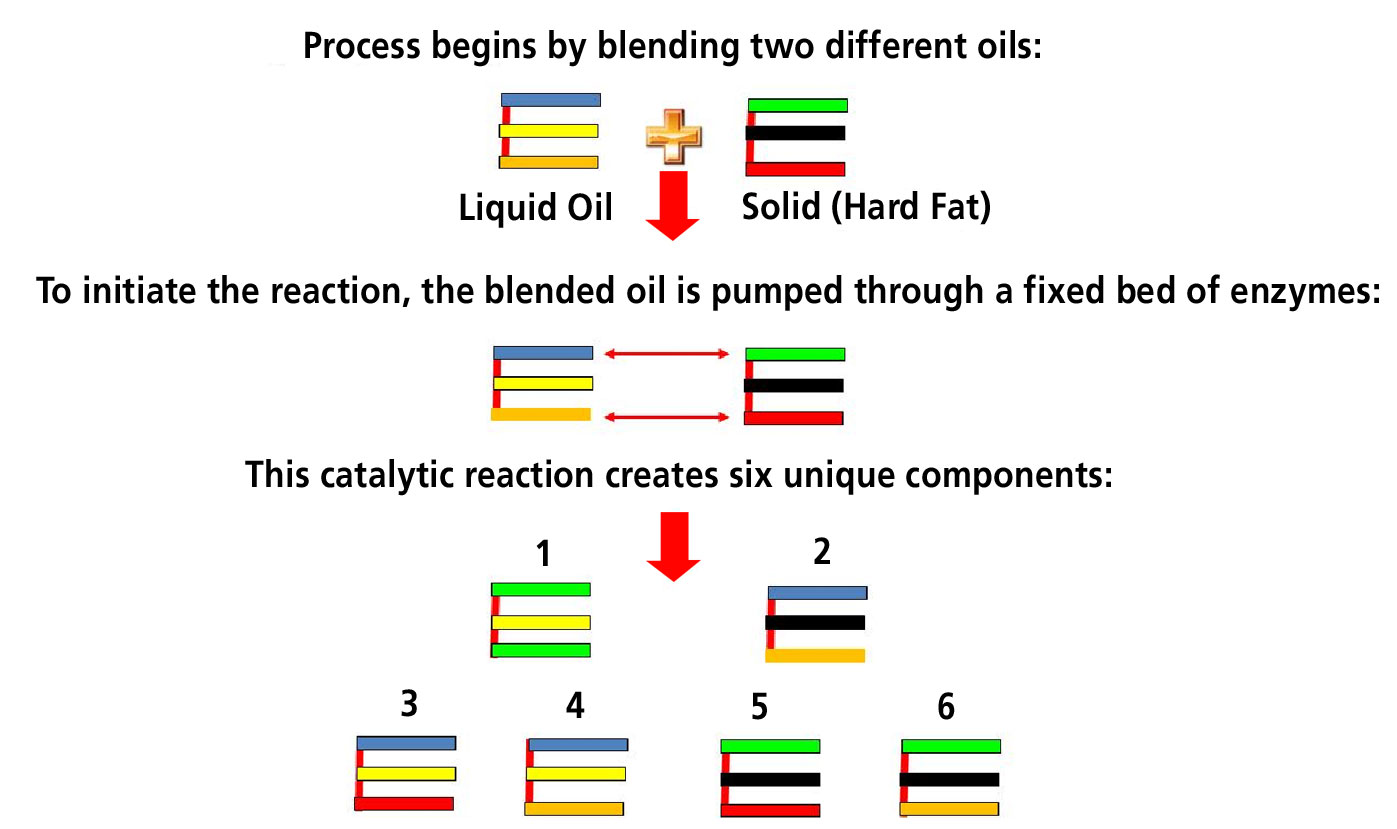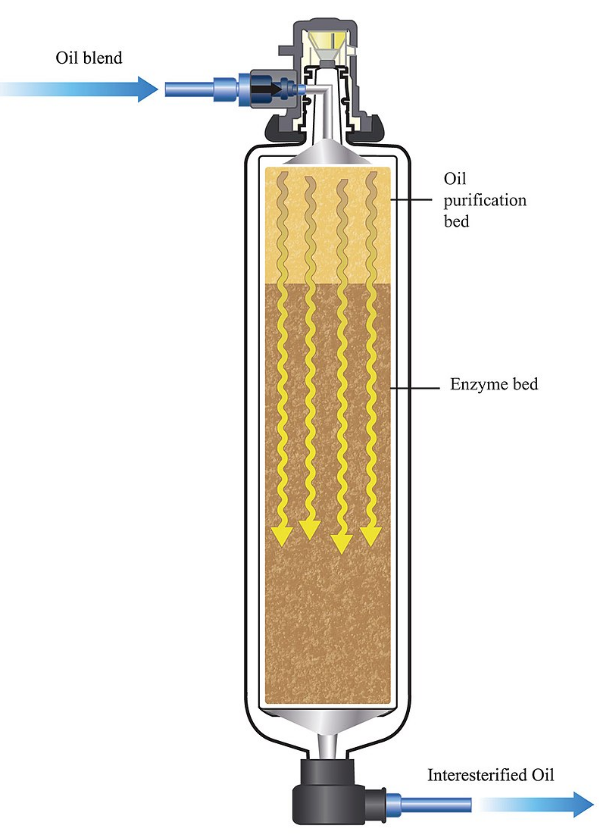Enzymatic Interesterification (EIE) is the catalytic reaction that occurs when an enzyme is introduced into oil and rearranges the fatty acids on the glycerol backbone of a triglyceride. Triglycerides are either liquid or solid at room temperature. The rearrangement of the fatty acids that occurs with enzymatic interesterification provides structure and functionality to triglycerides at room temperature. This process adjusts the melting properties, increasing functionality and plasticity in food production applications. One of five different ways of altering melting property profiles, enzymatic interesterification is unlike the more widely used partial hydrogenation method in that it produces no trans fatty acids and lowers saturated fat content.
- glycerol
- triglyceride
- triglycerides
1. Chemistry
Enzymatic Interesterification occurs when an enzyme is introduced into two oils; in most cases one oil is liquid and the other is a solid oil (hard fat). Hard fats are defined as fully hydrogenated fats. This process may occur in oils that already contain solids like palm oil or lauric fats that are not “hard fats."[1]

The reaction between the oils and the enzyme causes the fatty acids of the triglycerides to exchange positions to the -1 and -3 glycerides, thereby altering the chemical composition and physical properties of the fat. Using a 1,3-specific enzyme, only the fatty acids in the 1,3 positions are shifted around, and the 2-position is untouched. Unsaturated fatty acids in the 2-position are more often found naturally in plant lipids or vegetable oil sources. Allowing the rearrangement of the saturated fatty acids to occur in the 1-position and 3-position increases the amount of bioavailable unsaturated fatty acids.[2]
Enzymes most suitable for this process are esterase; acylase; those enzymes that facilitate acidolysis reactions, transesterification reactions, ester synthesis or ester interchange reactions; enzymes having phospholipase or protease activity, including thermostable and thermotolerant hydrolase activity; and polynucleotides.[3][4][5][6][7] From the two original fats, six different structures are produced during enzymatic Interesterification.[2]

A fixed bed system is the most common commercial process used for enzymatic interesterification. In a fixed bed process, the blended liquid oil and solid (hard fat) oil flow through a system consisting of an oil purification bed and an enzyme bed. The oil purification bed removes impurities from the oil blend so that the enzyme activity can be maintained at its highest performance. The enzyme bed allows for the enzymatic interesterification of the oil blend as the blend passes through the bed.[2]
1.1. Enzymatic vs. Chemical Interesterification
Interesterification can occur in two ways: enzymatic interesterification or chemical interesterification (CIE). In chemical interesterification, a catalyst (most often sodium methoxide), is added to a dry oil and the triglyceride exchange begins. This process occurs at high temperatures and creates three by-products (sodium soaps, fatty methyl esters and monoglycerides) in addition to the interesterified fats.[8]
Of the two interesterification methods, enzymatic interesterification is preferred for several reasons. EIE has fewer processing steps, occurs naturally at a lower temperature, produces no by-products and has lower production costs.[9]
2. History
The earliest record of enzymatic Interesterification was in 1844, when Théophile-Jules Pelouze published a study on the synthesis of a triglyceride through the esterification of glycerol by butyric acid.[10] In 1920, Wilhelm Norman, who also patented the catalytic hydrogenation of fatty acids, was granted a patent for the chemical Interesterification of edible lipids.[11] This process became a viable option for the food industry as it improved the spreadability and baking properties of the common shortening lard. At this same time, the food industry was rapidly adopting partial hydrogenation to meet their oil and shortening needs. Cheaper than esterification, partially hydrogenated shortenings were considered to be all-purpose and were used for a wide range of products.
Enzymatic interesterification was developed in the 1970s by the team at the Unilever Research Center at Colworth House in England. Their work proved that the use of a specific enzyme predictably rearranged the fatty acids on the glycerol backbone of a triglyceride at positions 1 and 3. This provided an expanded range of available triglyceride types, viable for any number of food production uses and also trans-fat free.[12]
Marketplace shifts in the late 2000s accelerated the commercial application of enzymatic interesterification. Most impactful was the push for trans fat removal from both foodservice and packaged food products, which nearly eliminated the commercial application of partially hydrogenated products. Still in its commercial infancy, oils and shortening produced from enzymatic interesterification can provide the taste consumers desire in foods in a cost-effective and sustainable manner for manufacturers.[13] As with the history of hydrogenation and trans fats, no research has been conducted into the impact on human health of enzymatic interesterification.
3. Process
EIE involves three key steps: pretreatment of oil, introduction of the reaction catalyst and deodorization of the oils.[2]
The EIE process can be executed in two methods: batch or continuous (single bed or fixed bed). In the batch process, the enzyme activity decreases over time, so flow must be carefully monitored and adjusted over time to maintain conversion.
In fixed bed continuous production, the enzyme levels vary in each reactor. The first reactor has the lowest enzyme activity and absorbs most of the impurities and harmful compounds. This sequencing protects the most active enzymes, which are in the last reactors.[14][15]
3.1. Advancements in Production
While EIE had been used by scientists for years, high enzyme prices as compared to the low cost of partial hydrogenation limited commercial application for many years. The development of granulation technology by Novozymes allowed full-scale industrial production to be explored. Granulation technology allowed for the EIE lipase catalyst to be available in a low-cost silica form for bulk fat modification.[16]
4. Food Industry Applications
Fats and oils created by enzymatic interesterification provide several benefits to food manufacturers. These oils provide better health profiles than either palm oil or partially hydrogenated oil because they are trans fat free and lower in saturated fat. The wide plasticity range and more consistent solid fat content create less variability in firmness, which is beneficial in production.[17]
Most often created through domestically sourced soybean oil, they provide a better risk management profile than globally produced palm oil. Lastly, producing enzymatic interesterified oil typically uses less processing and no harmful by-products creating a more sustainable, green process.[14]
Due to their physical characteristics, enzymatic interesterified fats have many food production applications, including cookies, crackers, biscuits, cakes and icings, dairy fat replacers, pie crust, popcorn, flatbread and tortillas.[18]
The content is sourced from: https://handwiki.org/wiki/Chemistry:Enzymatic_interesterification
References
- Costales-Rodriquez, R.; Gibon, V.; Verhe, R.; De Greyt, W. (2009), "Chemical and Enzymatic Interesterification of a Blend of Palm Stearin: Soybean Oil for Low Trans-Margarine Formulation.", J Am Oil Chem Soc 86 (7): 681–697, doi:10.1007/s11746-009-1395-2 https://dx.doi.org/10.1007%2Fs11746-009-1395-2
- “Chemical vs. Enzymatic Interesterification.” De Greyt, Wim. IUPAC-AOCS Workshop on Fats, Oils & Oilseeds Analyses & Production, 6 Dec. 2004. Retrieved October 20, 2010 http://old.iupac.org/symposia/proceedings/Tunis04/degreyt-interesterification-modifieddgw.pdf
- US patent 2001/0004462 http://v3.espacenet.com/textdoc?DB=EPODOC&IDX=US2001/0004462
- US patent 5,773,266 http://v3.espacenet.com/textdoc?DB=EPODOC&IDX=US5,773,266
- US patent 5,658,768 http://v3.espacenet.com/textdoc?DB=EPODOC&IDX=US5,658,768
- US patent 5,451,170 http://v3.espacenet.com/textdoc?DB=EPODOC&IDX=US5,451,170
- US patent 5,219,733 http://v3.espacenet.com/textdoc?DB=EPODOC&IDX=US5,219,733
- Rousseau, D. (2002) Chapter 13:The Effects of Interesterification on the Physical Properties of Fats. Physical Properties of Lipids. CRC Press.
- Hamm, W.; Hamilton, R., eds. (2000), Edible Oil Processing, Sheffield, England: Sheffield Academic, ISBN 1-84127-038-5
- Chim Phys 10 (1844). Pelouze, J. Ann. Page 434.
- DE patent 417,215 http://v3.espacenet.com/textdoc?DB=EPODOC&IDX=DE417,215
- Wisdom, R. A.; Dunnill, P.; Lilly, M. D.; Macrae, A. (1984), "Enzymic Interesterification of Fats: Factors Influencing the Choice of Support for Immobilized Lipase.", Enzyme and Microbial Technology 6 (10): 443–446, doi:10.1016/0141-0229(84)90093-0 https://dx.doi.org/10.1016%2F0141-0229%2884%2990093-0
- “Legal and Policy Resources on Public Health ‘Winnable Battles’” www.cdc.gov. Retrieved October 20, 2010. http://www2a.cdc.gov/phlp/winnable/transfat.asp
- US patent application 0138867 http://v3.espacenet.com/textdoc?DB=EPODOC&IDX=US0138867
- US patent application 0317902 http://v3.espacenet.com/textdoc?DB=EPODOC&IDX=US0317902
- “Enzymatic Interesterification: Process Advantages and Product Benefits.” Husum, T. L., L. S. Pedersen, P. M. Nielsen, M. W. Christensen, D. Kristensen, and H. C. Holm. Palm Oil Information Online Service, Dec. 2003. Retrieved October 20, 2010. http://palmoilis.mpob.gov.my/publications/pod39-p7.pdf
- Osório, N. M.; Dubreucq, E.; Da Fonseca, MM R.; Ferreira-Dias, S. (2009), "Operational Stability of Immobilized Lipase/acyltransferase during Interesterification of Fat Blends.", Eur J Lipid Sci Technol 111 (4): 358–367, doi:10.1002/ejlt.200800194 https://dx.doi.org/10.1002%2Fejlt.200800194
- Hui, Y.H. (2006), Handbook of Food Science, Technology, and Engineering, Vol.1, Boca Raton: Taylor & Francis, ISBN 1-57444-551-0
